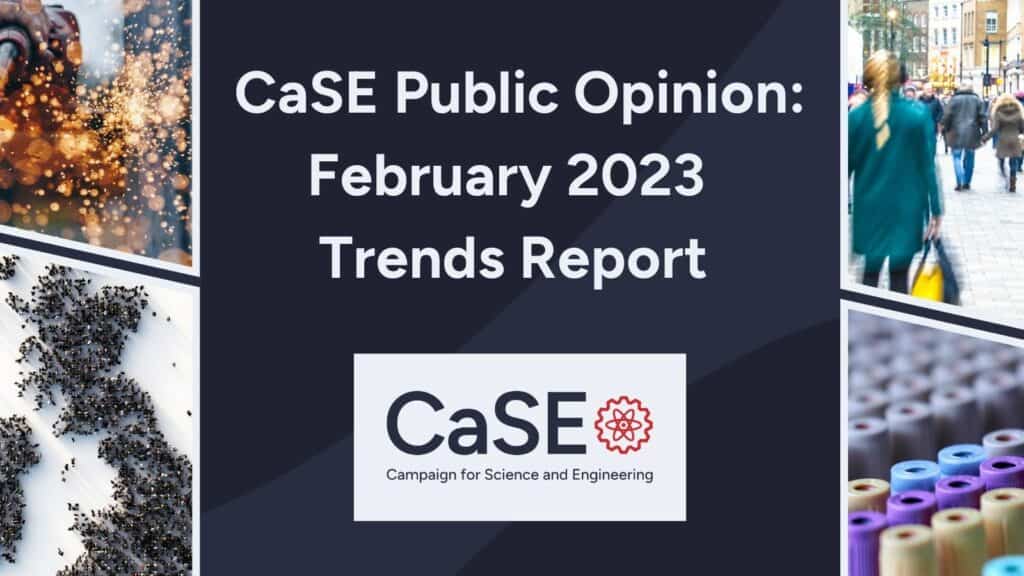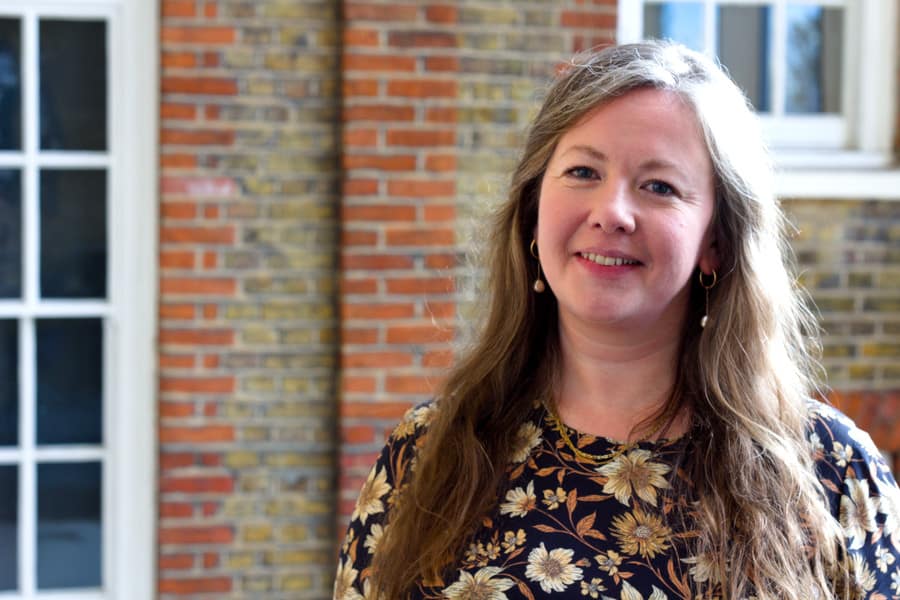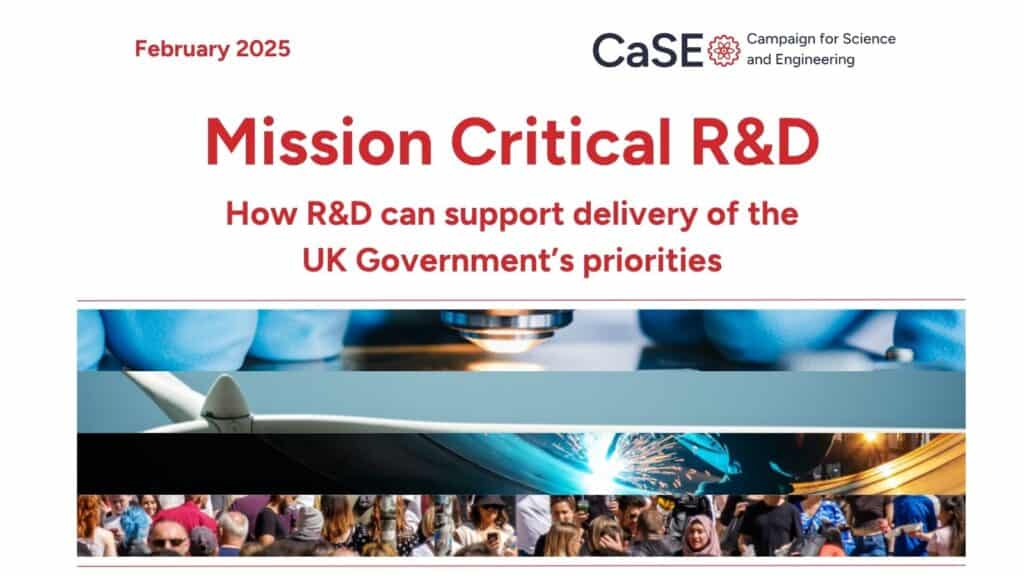This report reflects the findings of a major study of public opinion conducted as part of the Campaign for Science and Engineering’s (CaSE) Discovery Decade programme. This study spans 14 focus groups and four nationally representative polls spread across almost a year in 2022-2023, anchored by a landmark 8,000-person poll in July 2022.
Introduction
Here, we highlight the eight trends that we see emerging from the data, and in the full report we also collate the key findings and headline statistics from the study.
Government investment in R&D is supported by a large majority of the public
Our efforts to build the R&D sector’s public image aren’t cutting through
People struggle to see the benefits R&D, which risks it being labelled a ‘luxury’
R&D’s poor connection with younger people is a major, and growing, risk
In our polling, 70% of people felt it was important for the Government to invest in R&D, with stronger support among the over 65s and the AB socioeconomic group (those working in intermediate and higher managerial professions). This support means R&D advocates start from an enviable position as we seek to make our case for investment.
There’s even appetite for further political ambition in this area, with over half of people saying they would like politicians to pay more attention to science and innovation. Crucially, this view is held equally by Conservative and Labour voters, while almost threequarters (73%) say the UK needs to be better at science and innovation. These are some of several demonstrations across the data that there is cross-party support for an ambitious stance on R&D.
In addition, the public are keen for the UK to use new and creative ways to overcome the problems we face as a nation, and when we asked people why investing in R&D was important to them, they told us that it could benefit future generations, keep people healthy and keep the UK safe and secure.
The language we use as advocates isn’t always reaching our audiences, and more than half (52%) of people either haven’t heard of the acronym “R&D” or have but don’t know what it means. The same proportion say they know nothing or not very much about R&D.
“I’ve heard of it [R&D]. But I don’t actually know what it is”
For many people in our focus groups, the term “R&D” primarily evokes consumer tech, large businesses, and medical treatments – leaving large parts of the R&D system
unseen. The contribution to R&D made by our universities and charities received little to no recognition without prompting, and there was a strong bias towards STEM-related subjects over wider examples of R&D, further narrowing the sector’s image.
Efforts to give R&D a clear ‘brand identity’ are struggling. The Government’s “Science Superpower” tagline hasn’t cut through; only 12% of people say they’ve heard of it and know what it means. But, the more tangible messaging used by the Department for Science, Innovation and Technology has potential, with people responding favourably to the idea of R&D delivering “stronger growth, better jobs and bold new discoveries”.
Just over 60% of people either agree that “R&D doesn’t benefit people like them” or feel neutral or unsure about R&D’s impacts; peaking at 72% for those aged 35-44. This is a precarious position for a sector that receives substantial public investment.
“Wealthy people” and “big businesses” are cited as the major beneficiaries of R&D, and people view R&D activity as being clustered in London and South East England. Without clearer messaging about R&D’s benefits and its UK-wide footprint, it could be seen as something that’s primarily for the benefit of wealthier people, and happening in the UK’s wealthier regions.
[Discussing the affordability of new heat pump technology]: “None of the working class people actually get that. You can put all the R&D and money into it you want, but you’ve got to make it accessible to everybody.”
“It’d be nice to see some returns, or some evidence that the investment that we’re putting in has created something. At the end of the day, it’s taxpayers’ money. It’s our money. And we never see detail.”
Unsurprisingly, given its intangibility to many people, R&D risks being labelled a ‘luxury’ rather than a necessity, especially amid a cost-of-living crisis. When presented with a hypothetical Government proposal to immediately halve the R&D budget, a third of people are supportive and this increases to an outright majority when the cut is framed around tangible alternative priorities such as lowering energy bills. Given the choice, 46% of people would only invest more in R&D when “the economy is in better shape”, and in our focus groups people spoke about innovation just making everyday life more expensive.
“If there wasn’t as much of a crisis today – with the gas, electric, diesel, and the NHS – I could be more content with investing in more research for the future. Research helps and is needed, but right now we need to focus on what is happening here and now.“
“It’s almost a luxury to fund R&D at this moment. It would be nice to put other areas that the government oversees in order before we start spending money on possible, probable, maybes and maybe nots.”
Age was one of the strongest differentiators of opinion across our polling. Older people were among the strongest supporters of R&D investment, but younger age groups are less likely to feel R&D benefits them or that R&D can create local jobs in their area, and more likely to say that we cannot afford to invest in R&D at the moment. They’re also more likely to say that the UK doesn’t need to invest in R&D because it will benefit from R&D done abroad.
However, there are promising avenues that could help us make R&D more relevant to younger people. We can focus on the outputs that matter more to them; younger people are more excited by new products and technologies. We can also lean into cooperation centred arguments linked to national pride, as we see stronger support for the idea of the UK being “known worldwide for its science and innovation” versus more adversarial framings about the UK “falling behind” similar countries.
People are concerned about the cost of living, the sustainability of the NHS and the impacts of climate change. In general, arguments that linked R&D to a tangible problem – even if this solution is a long way off – help win people over. There is huge scope to strengthen this link between R&D and the key issues facing people to make our advocacy more relevant and compelling.
Promisingly, people see R&D as a relevant tool for solving lots of different problems in society, including tackling climate change and improving the quality of the NHS. And more than half of people felt that R&D was either essential or important for addressing the cost of living.
On the flip side, some of the sector’s typical arguments aren’t proving effective. Rationales that centre around the UK “falling behind” in R&D investment compared to other nations don’t motivate support among most people, with one focus group describing these rationales as “blackmail”. Similarly, arguments framed around the economic spillover benefits of R&D tend to be less effective than those focussed on the problem that the R&D was directly intended to fix.
There is scope to talk more about where R&D happens. About a third of people associate R&D with their own region – citing tangible examples such as nearby universities, NHS institutions and businesses – and many want their region to carry out lots of R&D.
Despite this, the local visibility of R&D is low. About two-thirds of people say they don’t know much about R&D happening in their area, and a similar proportion would like to hear more about it. Strengthening R&D’s local roots could also yield powerful new spokespeople, as people say they would trust those working in R&D in their area to talk about its benefits.
“I had never heard of [graphene being discovered in Manchester]. Is that because we’re supposed to take the time and find out? That’s the type of thing I’d like to see put on social media… let’s be proud!”
As the footprint of R&D expands, we should consider what benefits people are expecting to see from developments appearing in their area. About as many people would support a new research lab being built in their local area as would support a new school or wind farm, which is more than would support a new train station, factory or shopping centre. When asked why, 62% of those who would support a new research lab being built say it would benefit the local economy, 60% say it would bring more well-paid jobs to their area.
When it comes to talking about how much public money should be invested into R&D, people trust R&D experts despite being conscious of their potential self-interest. Researchers, research charities and universities strongly outperform politicians as messengers on investment, with businesses falling somewhere in between.
After seeing scientific experts in action during the coronavirus pandemic, many people hold them in high regard and consider them well-placed to speak about R&D. In focus groups, participants referred to those involved – often by name – and praised their expertise, evidence and honesty.
“So those two guys that used to stand either side of whoever gave us the Covid news became popular. They told us how many people had died, all the boring, horrible stuff, but what was good about them was that they did what it said on the tin. They’re the real deal. They’re not someone trying to be something, they are it. They breathed it, they did it. It’s refreshing to hear people speak about things they know about.”
Politicians, of all stripes, perform poorly as ambassadors for R&D. They were seen by focus group participants as inherently untrustworthy and unlikely to keep promises, further emphasising the need for the R&D sector to agree and articulate its own rationale for investment.
Throughout the study, we sensed a lack of optimism in many people. Although people feel they are “better off now than 50 years ago”, they also believe that things are
“changing for the worse” and that the future is scary rather than exciting.
Many people feel motivated by a desire to improve things for the next generation. Personal benefit still matters, but we also saw strong support for altruistic motivations
for investing in R&D such as building a better future for others. There is an opportunity to frame R&D as an essential tool in achieving a better future – whatever people may want that to be.
“It should also be the first tick that has to be put against any [R&D] project: will this
contribute to making the world a better place for the next generation?”
The data offers hope to advocates too – people can be emotionally engaged with the idea of R&D when it feels relevant to their lives and passions. Building that personal connection will rely on more personalised advocacy – this data is a reminder to avoid messages that lump the public together as one big audience, and instead see and respond to the differences in society. We see these different mindsets even within demographic groups, so this study has focused on capturing the data we need to find the things that unite people – whether that’s their passions, hopes or attitudes.
Nurturing a more personal connection with R&D is no easy task, but the better we
understand our different audiences and their opinions, the easier it will be to get started.
Downlaod the full report to explore the key findings
This work was supported by the Wellcome Trust [222853/Z/21/Z]
















